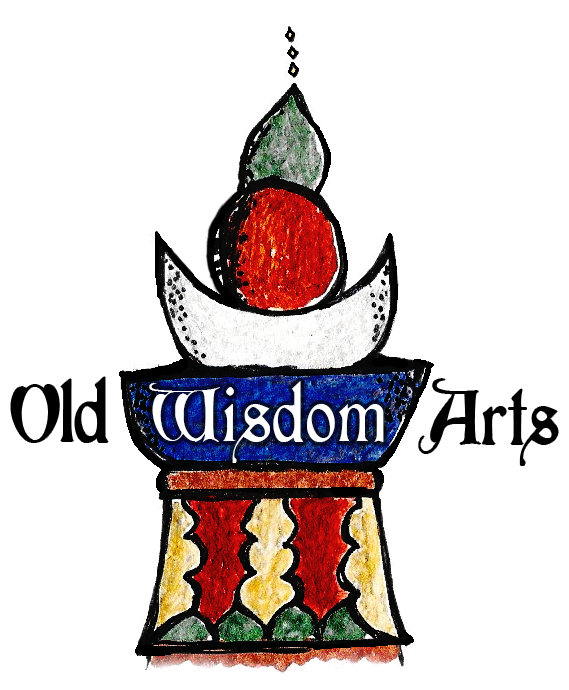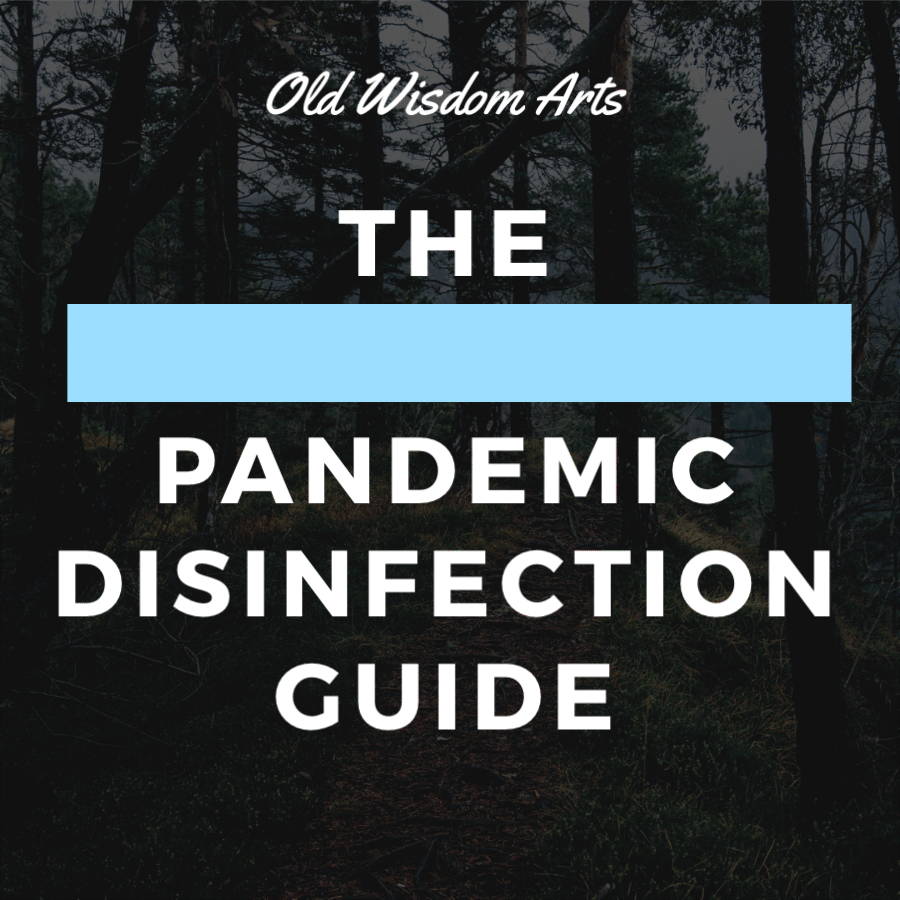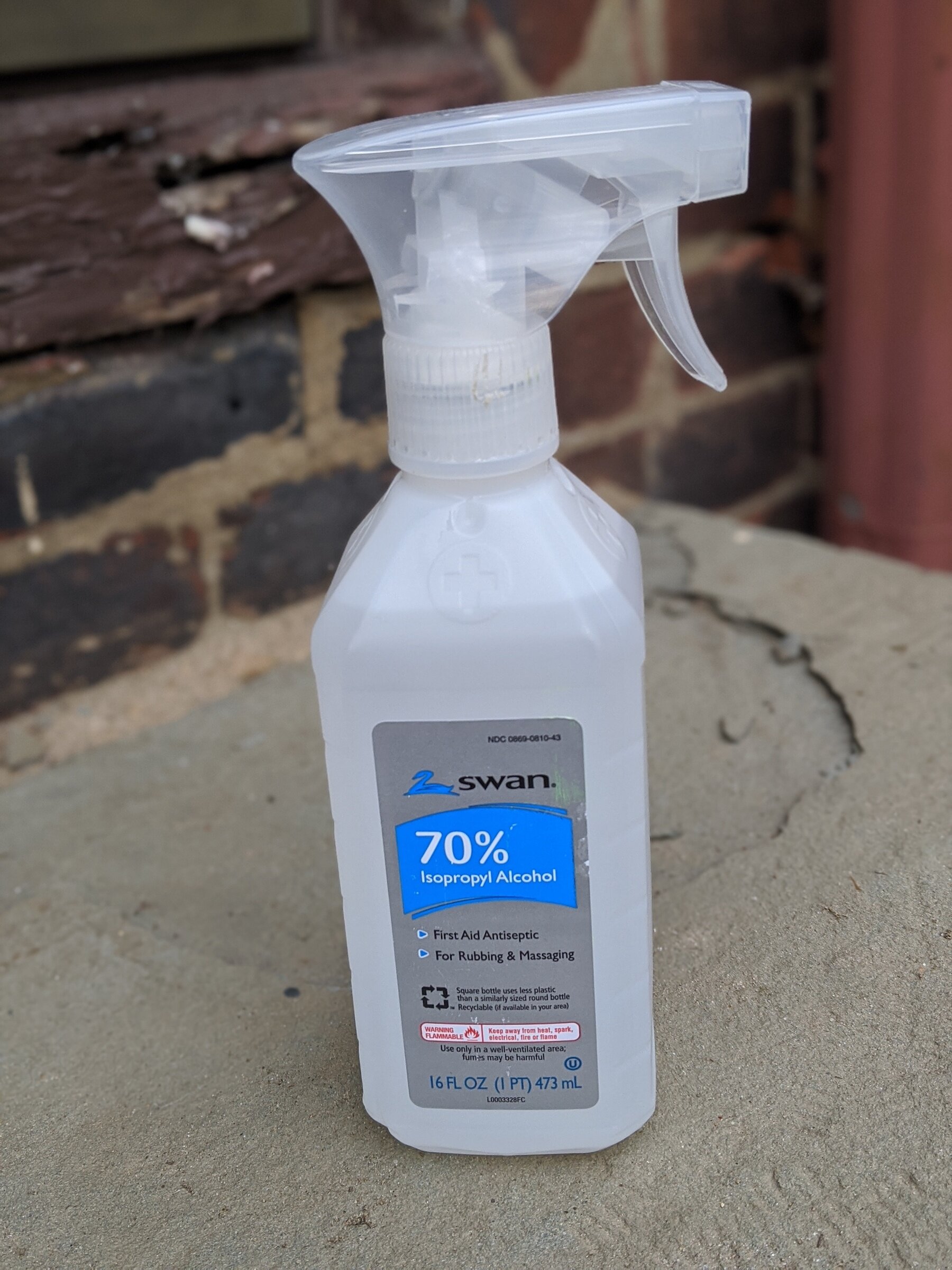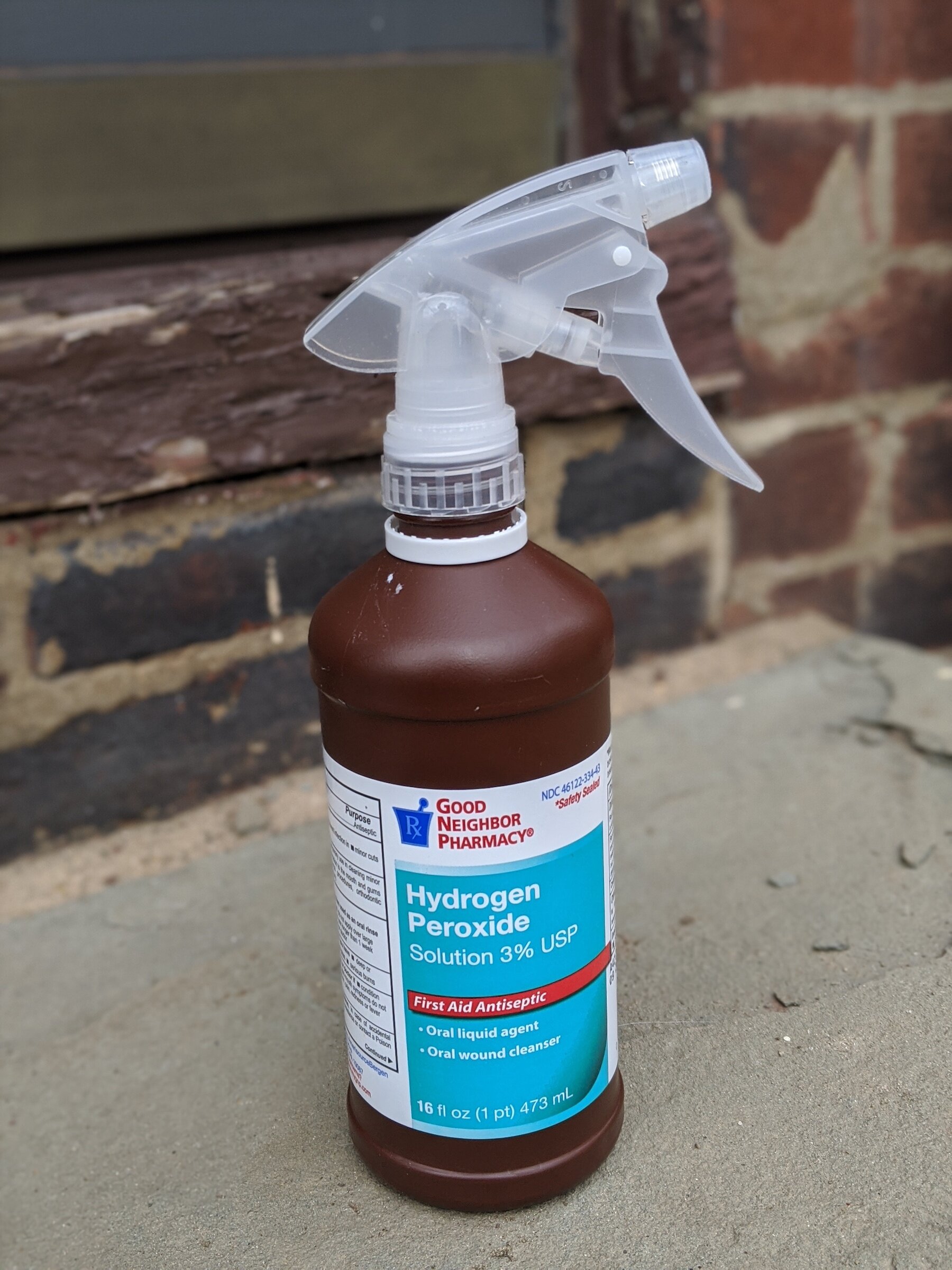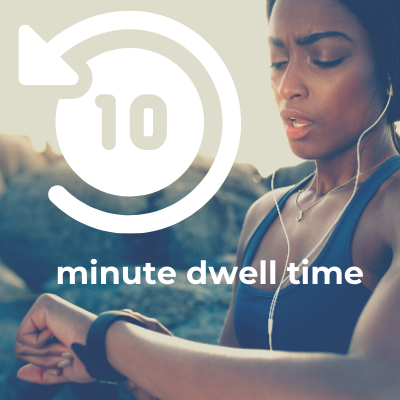What ingredients deactivate SARS-COV-2?
Alcohol
Hydrogen peroxide
Chlorine-based bleach
Soap and water!
Thymol (from thyme)
I like to keep three bottles at the ready for home disinfecting. I save up spray tops from discarded cleaner bottles (washing thoroughly before re-use) for this.
Bleach and Water solution: anything with a larger surface area where there’s good ventilation (ideally outside). Safe on non-perishables that come in cans or thick plastic. Great for buckets and plastic tubs and the like. Favour oxygen bleach when you can get it (safer than chlorine bleach).
Alcohol: given this one is the quickest acting, it’s my go to for most things: hands, non-perishable groceries, smaller surfaces. It’s in very short supply so I don’t use it for disinfecting larger items or surfaces like sinks and countertops.
Hydrogen peroxide: great environmentally-friendly alternative to chlorine bleach. Easier to procure than alcohol. Excellent for doggy paws post-walk, kitchen sink, produce.
In order for any disinfectant to perform well the surface should be clean.
Oh, and one of the bigger takeaways you’ll get from this guide?
⬇
⬇
⬇
It’s called dwell (or contact) time, friends. It’s the amount of time a surface must remain visibly wet in order to kill pathogenic micro-beasties before the disinfectant is wiped off. Said surface also needs to be left undisturbed. I’ll be giving you the low-down on dwell time for each of the chems listed above!
Disinfection of Surfaces
Doorknobs, countertops, handrails. As long as everyone in your home is quarantining, you likely won’t need to worry about much more than the mailbox and front door knob/knocker and any handrails outside. However as we start to open the economy back up, you’ll need to start thinking about the most frequently touched surfaces in your home: these will need to be disinfected on the regular.
Throughout this guide I’ll be reminding you that not only does disinfection take time, but the surface needs to remain saturated for that time. Which is one of the qualms I have with wipes…
What about disinfectant wipes?
Read the instructions on the bottle carefully. Most disinfectants require time to deactivate the virus — it does not happen instantly! DO wipe down your grocery cart, but let it stay saturated for the amount of time listed. If you are in a high-risk category, this is a measure you’ll want to consider. Also beware of certain ingredients — things like fragrances and Quaternary Ammonium Chloride Compounds (Quats) — they can mess with the endocrine and reproductive systems. Wherever possible, use unscented cleaning products that have been certified by third party organizations like Green Seal, EcoLogo or Design for the Environment.
Let’s start with an overview of disinfectant ingredients.
The Evidence
Given the preliminary nature of almost all scientific literature around SARS-COV-2 (peer-review takes time), the info below is based on a combination of recent evidence as well as prior studies on similar, lipid-enveloped viruses. Where concentrations of chems and dwell times are higher for previously well-studied viruses than the preliminary info on SARS-COV-2, I’ve gone with the higher number to be safe. Supporting links are directly in the text, otherwise see the resources section at the end for studies referenced as well as helpful science-based journalism around household cleaning.
Hydrogen Peroxide
Ah, the less intense ‘oxygen’ bleach — so named ‘cause when it releases its unstable oxygen in a reaction, it ‘bleaches’ what it sticks to. Breaking down into oxygen and water means it’s better for the environment (and many surfaces, fabrics and your hands) than chlorine bleach. Tho if you had pure HOOH you could start a fire real quick. So, you know, you’ll only find that stuff in a lab.
For the sake of ubiquity, we'll be talking about the typical over-the-counter opaque brown bottle at your local pharmacy, standardized at 3%. However, you can also look for oxygen bleach (which would be a little stronger and likely have a quicker dwell time — as always read the bottle carefully!).
We don’t have any literature yet to confirm whether basic HOOH works specifically on SARS-COV-2, but it has been shown to deactivate rhinovirus. Rhinovirus is the common cold bug and is trickier to deactivate than SARS-COV-2. As a rule of thumb, disinfectants that are effective at deactivating sturdier viruses are approved by the EPA for emerging pathogens that are easier to deactivate (like lipid-enveloped coronaviruses). Do note tho that some disinfectant cleaners contain accelerated hydrogen peroxide, which can deactivate SARS-COV-2 quicker than your OTC stuff. These improved hydrogen peroxide (IHP) solutions have been more widely tested as disinfectants, especially on soft surfaces like curtains, and some are included in the EWG’s list of 16 safe disinfectant cleaners.
Clean first with soap and water.
Must be at least 3% hydrogen peroxide: read labels carefully.
Takes 6-8 minutes to completely disinfect: increasing with decreasing concentrations (18-20 minutes at 1.5%, 50–60 minutes at 0.75%)
Decomposes easily: Most folks recommend tossing at 3 years. Keep in dark bottles away from heat and sunlight.
Biodegradable: readily breaks down into oxygen and water.
Can damage some surfaces: do a spot test on aluminum, brass, copper, galvanized steel, natural stone, plastic that is porous, rubber, silver, wood, and zinc.
Alcohol
This was a tough one to get accurate info for! Finally a study has been published on SARS-COV-2 and inactivation via alcohol (and alcohol-based hand sanitizer). While exciting it’s not exactly a confirmation as most research into SARS-COV-2 is preliminary and has not been peer-reviewed. For this reason I have stuck with a higher concentration of alcohol until we have confirmation (the report above says as little as 30% is effective but most lipid-envelope viruses require higher concentrations). Ethyl alcohol (ethanol, like Everclear) is a powerful broad-spectrum germicide and is considered generally superior to isopropyl alcohol. Use one or the other but nothing else: others like methanol or butanol are toxic and definitely not safe.
Clean first with soap and water.
Must be at least 70% alcohol: read labels carefully. Most spirits in your liquor cabinet don’t exceed 40% alcohol, which isn’t enough to kill coronavirus.
Mix with cold water, never hot: heat causes alcohol to evaporate and can dilute the concentration of your solution.
Store in a tightly sealed container: again, alcohol is vulnerable to evaporation.
Safe for most surfaces: but can discolour some plastics.
Maybe don’t spray it near a lit stove: you know, ‘cause it’s flammable.
My favourite disinfectant for grocery items: takes the least amount of time and doesn’t smell as bad as bleach.
Chlorine Bleach
In household products, bleach can refer to any chemical that whitens: chlorine, ammonia, hydrogen peroxide. For our purposes, I’ll be referencing 5% sodium hypochlorite (chlorine-based bleach) — one of the more common household variants.
I will admit that I hadn’t used chlorine-bleach for more than a decade until the pandemic ‘cause of its questionable safety. The environmental impact may be debatable (depends on concentration and application), but it’s empirically pretty harsh on your lungs. Classified as an asthmagen, it can actually cause or trigger asthma. It’s been tough to get my hands on Everclear or rubbing alcohol so I’ve been using this one occasionally for surfaces — just keep the room well-ventilated!
Bleach degrades quickly & easily.
Refresh daily: After 24 hours your solution may not work*!
Leave on surface at least 10 minutes. 30 minutes if you are soaking.
Store in a dark/opaque container: bleach is sensitive to light*.
Mix with cold water, never hot: bleach decomposes when heated*.
Clean first: organic materials deactivate bleach*.
Reacts easily with other chemicals: only mix with water! Some combinations can emit toxic gas.
Check the expiry: if past prime it will be ineffective.
Bleach can do damage: especially fabrics, soft or porous surfaces. It will corrode many metals and it best not to use on stainless steel, aluminum, copper, brass, marble, or granite.
Hand-washing
Soap and Water
You know the drill — this part takes at least 20 seconds. If you’ve been mostly at home for the lockdown you may want to start getting used to doing this again as our leaders negotiate reopening the economy.
One round of the Green Tara mantra works well for this. You can hear it on my IG: clicky clicky.
“Scrub like you’ve got sticky stuff on the surface and you really need to get it off,” — Richard Sachleben, an organic chemist and member of the American Chemical Society. Just the friction from scrubbing with soap and water can actually dissolve the coronavirus’s protective envelope. Most importantly the soap molecules actually pry the lipid (fatty) envelope of coronavirus apart (more nerdy intel on this under resources at the end of this guide).
Always use a fresh towel! Remember the towel is removing any viral particles that might be left on your hands.
Anytime you’re returning from outside, or handling potentially contaminated stuff, toss the towel afterward (straight into a laundry bin or the garbage if it’s disposable).
Keep a stack of face cloths in the bathroom instead of a single hand towel, with a clean bin under the sink to toss the laundry.
Hand Sanitizer:
Bottom line? Anything you use must be at least 60% alcohol.
Most effective paired with a paper towel or tissue: the mechanical action of drying your hands on something after washing/sanitizing them helps removes the virus.
Go through the same motions (and time!) as washing hands to get full coverage.
Hand Sanitizer Recipe
Yes, you can make your own! Start with the highest concentration alcohol you can find. The lower the concentration the less you’ll be able to add to it.
The simplest recipe is 1 cup 91-95% alcohol + 1/4 cup aloe vera gel — add to a bottle and shake to blend!
Only use isopropyl alcohol (rubbing alcohol) or ethanol (grain alcohol, everclear). You can add a couple drops of essential oil but don’t go overboard — the more sticky stuff on your hands the more places for the virus to stick to.
Do you need to disinfect your groceries?
The jury is out so far on this one, as person-to-person contact via respiratory aerosols and droplets seem to be the most important vector for this disease — the action of inhaling the particles directly into the respiratory tract is the kicker here! Contaminated food that you consume should hopefully get deactivated by your stomach acid. Without definitive evidence that this isn’t a potential vector, I’ve been playing it safer than most by cleaning and/or disinfecting every item. If you’re in a higher risk category or hotspot with limited hospital resources, you might want to play it safe, too.
NPR has published an excellent shopping guide, vetted by scientists. They also suggest that grocery disinfection isn’t necessary. The divide here is really just reflective of how much is still uncertain. Given preliminary evidence of the persistence of viral particles on surfaces, I’ve decided to disinfect whatever I can to keep exposure at a minimum. Some reports show the virus degrades after two days on cloth or cardboard, but others have found traces of it on those materials after six or seven days. Is it enough viral load to produce infection? Probably not, but we don’t know for sure.
Ultimately it’s your call on grocery disinfection. Here’s how I clean my loot:
So what do you do when the grocery delivery arrives, or you get home from the store? The NPR link above can help with the store part. I’m here for what comes next. Depending on your comfort and risk-level, you may want to keep everything outside your door or in a garage/anteroom as you disinfect. In a lab setting, controlling the environment in your ‘clean room’ is the key to your success — you may even need to shower before you go inside. Some folks will strip and bag their clothes in an outer room before heading to the shower. Unless you are working in a front-line healthcare, this level of care is likely unnecessary — however if you think someone coughed or sneezed your way, it’s a reasonable precaution to take.
Everything other than fresh produce I disinfect with 70%+ alcohol before bringing inside. I place it inside a large plastic tub, waiting the 30-60 seconds disinfection time before wiping down and putting away (or longer if you’re using something other than alocohl).
Next, I place all the produce in a separate clean bag, sealing it before bringing inside. I’ll either put it directly in the fridge, cleaning each item as I use it, or I’ll wash all the produce right away.
Keep in mind: washing your produce can cause it to deteriorate faster. Things with softer skins/peels especially. Things like citrus and bananas hold up well to washing up straight away — but I’ve had a tough time with moulds on zucchini.
Get yourself a container that fits in your fridge to safely store the ‘contaminated’ produce away from other food.
Equally important as washing your food is the sanitation of the prep area and tools, from sinks to cutting boards. Don’t forget to clean and dry your vegetable brush between uses. And always wash your hands before and after washing produce.
To soap or not to soap? The consensus seems to be that it’s unnecessary and potentially irritating to your gut lining. If you have a natural fragrance-free soap (like unscented castile soap), using a little won’t hurt for stuff that’s particularly dirty — just rinse thoroughly and immediately after use (don’t soak in soap and especially don’t use anti-bacterial, fragrance-laden dish soaps!)
How I clean my produce:
Scrub under COOL running water. Hot water can allow things (like germs) to be absorbed by the very porous surface of produce.
Soak with clean cool water for 3-5 minutes. If you aren’t able to scrub something or your produce source is particularly dubious, add 1/3 cup 3% Hydrogen Peroxide to your soaking water and leave it for 30 minutes (then rinse thoroughly). Things with tough skins like bananas and oranges I’ll skip soaking and just spray with the hydrogen peroxide, leaving for 6-8 minutes before rinsing off.
Dry. Again, if particularly dubious, hand dry with clean towels or paper towels. If not, just leave it on the counter on a clean towel to air dry.
How to clean non-perishables.
Given that the viral load dissipates much more quickly on irregular/soft surfaces than hard ones, I get a little more aggressive with cans, bottles, and the like. When I only had bleach left I found out the hard way how easily it can damage plastics — I rendered a couple bakery items in softer plastic inedible after it leached into the goods. So which disinfectant for which items?
Cans, glass bottles: any of the suggested disinfectants in this guide are suitable.
Cardboard & soft plastic: alcohol is my favourite (it’s quicker) but it’s one of the more difficult to obtain. Hydrogen peroxide works good here, too. Remember to saturate! If cardboard items have an inner sleeve, you may just prefer to dump them out and toss the box.
If your grocery source is particularly dubious you may want to wash your groceries first before disinfecting them, or at the very least wipe down each item with a clean towel/paper towel after disinfecting.
Before we go, let’s talk about the promise of thymol.
I’ve included Thymol because it is among the most exciting of the emerging natural disinfectants: it comes from Thyme! Unfortunately it’s tough to get your hands on thymol-based disinfectants and it’s unclear how stable thymol is in homemade products. The EPA does list some thymol-containing products on its approved disinfectant list, but nothing I’ve seen that’s readily available.
Given the envelope of this virus is fairly easy to dismantle, thymol products are expected to be effective, and many are in the EPA’s Emerging Viral Pathogens program (this program allows disinfectants that have been proven to eliminate harder-to-eradicate viruses to be used).
Thyme EO is about 30% thymol (check GC/MS report for exact percentage). My fav: Benchmark Thyme.
Used in many Seventh Generation disinfectant products, Bioesque Botanical Disinfectant, and CleanWell products.
Not listed as an asthmagen but when I’ve cleaned my bathroom with it (ie. a small space) it hasn’t felt great to inhale it.
Commercial products all list 10 minute contact time to disinfect.
Potential uses for cleaning the air are interesting to think about (ie. diffusing), but there’s no evidence that’ll work.
Oh, and vinegar…?
It’s not effective against coronavirus.
It does have efficacy against some other pathogens, tho, as in these studies:
In this study lemon juice and vinegar were able to reduce the total number of pathogens to undetectable levels in 15 mins, boding well for salad!
Vinegar can inhibit growth of and kill some food-borne pathogenic bacteria. Plus, the bactericidal activity of vinegar increased with heat! (Salt was helpful, too.) “The combined use of vinegar and sodium chloride, with use of an appropriate treatment temperature, was found to be markedly effective for the prevention of bacterial food poisoning.”
A combo of vinegar and baking soda were very effective against potential bacterial pathogens but less-so than commercial household disinfectants.
RESOURCES
List N from EPA of approved Disinfectant products: https://www.epa.gov/pesticide-registration/list-n-disinfectants-use-against-sars-cov-2
Full list of hard-surface disinfectants for use against coronavirus (COVID-19) by Health Canada: https://www.canada.ca/en/health-canada/services/drugs-health-products/disinfectants/covid-19/list.html
Bleach and alcohol as disinfectants (esp. how to dilute bleach properly): https://www.ncbi.nlm.nih.gov/books/NBK214356/
EWA assessment of bleach: https://www.ewg.org/guides/substance_groups/107-Bleach/
Helpful interview Dr. Stephen Thomas of Update Medical University on household cleaning products that can destroy coronavirus https://www.consumerreports.org/cleaning/common-household-products-that-can-destroy-novel-coronavirus/
Deadly viruses are no match for plain, old soap — here’s the science behind it
How does hydrogen peroxide work? Love this prof’s explanation: https://www.youtube.com/watch?v=OLUyeCC-2Ko
